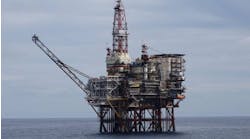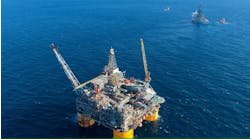HORIZONTAL, EXTENDED REACH DRILLING Phillips multilateral features several firsts for North Sea
Brent LowsonDuring September 1996, a biplanar multilateral well was successfully drilled and completed in the Norwegian North Sea using a system with selective through-tubing re-entry and isolation capabilities. The multilateral - 2/7B-17A/B drilled from the Bravo platform - was completed for Phillips Petroleum Norway in the Eldfisk Field in the Greater Ekofisk area of the Norwegian Sector in the North Sea. The completed well exceeded technical and financial objectives by using a mainbore horizontal and an uphole horizontal lateral to tap into two different producing zones of the Ekofisk and Tor formations.
Sperry-Sun Drilling Services
The Ekofisk and Tor formations are in the Eldfisk Field. The Eldfisk Field lies to the south of the Ekofisk Field and is part of the Greater Ekofisk area.
The term "biplanar" indicates that the well drains two different geological zones. While such laterals are not necessarily parallel, they are in two nonincidental, horizontal planes - roughly the relationship between the two producing formations in question.
The well design provided a lower lateral in the primary target zone - the high permeability chalk Tor formation - as well as a second horizontal lateral in the shallower Ekofisk formation.
The well was directionally drilled in June 1984. It was abandoned until August 1996 when the existing casing was section-milled at about 1,195 ft to allow re-drilling a biplanar well.
Procedure - Main bore
The well was sidetracked to 4,900 ft in 17 1/2-in. hole in which 13 3/8-in. casing was set and cemented. The 12 1/4-in. main wellbore was drilled to an inclination of 40 degrees, dropped to 0 degrees, and then built in the opposite direction to 10,894 ft MD, at a 48 degree inclination. After setting 9 7/8-in. casing, an 8 1/2-in. section was drilled with a 90 degree inclination, an 18,455 ft TD, and a lateral displacement of 7,500 ft. The build and drop profile, plus the rebuild to horizontal, allowed maximum exposure of the reservoir section immediately below the original, uphole abandoned casing string.The 8 1/2-in. section was lined with a 7-in. liner, included a lateral tie-back system window joint, and crossed over to a 5-1/2 inch liner string. A retrievable MWD tool, in the running string above the liner, was used to orient the window to the required direction. This tool was retrieved with wireline prior to cementing.
During cementing operations, a Nodeco swivel permitted rotation of the liner string below the window joint to ensure proper cement placement for hydraulic isolation. The cementing operations were completed and the internal sleeve, used to provide pressure integrity during cementing, was retrieved from the multilateral system while pulling the inner cementing string. An isolation plug was placed below the multilateral window for isolation of the main bore while drilling the upper lateral.
Procedure - upper lateral
The multilateral system's deflection tool was set into the landing profile to lock the device in precise axial and radial orientation. (Since the multilateral system chosen does not restrict the primary casing internal diameter, the operator is free to drill laterals in any sequence.) A steerable drilling assembly was then used to drill off the face of the deflection tool through the composite wrap. Entrance into the formation was accomplished in less than 30 minutes. The 4 3/4-in. hole section was drilled from the exit point of the 7-in. window at 10,935 ft, to 12,700 ft TD, re-entered and logged with pipe-conveyed tools.Completion and stimulation
A unique feature of this Ekofisk well is a Dresser Oil Tools completion system designed to use modular features of the Sperry-Sun's multilateral systems. A mechanism incorporated into the Dresser Oil Tool system permits the installation of drilling and completion tools at wellbore junctions without obstructing the main casing diameter or the branch liner dimensions. The completion allows main or branch well re-entry through the production tubing and without rig intervention. The upper lateral is open-hole in a limestone formation and can be re-entered for re-drilling if access is lost due to reservoir subsidence.The Dresser Oil Tools completion system (with a reinstalled internal isolation sleeve) was comprised of a tie-back liner, with a 5 3/4-in. x 12-in. locator seal assembly, a 20-ft x 5.065-in. seal bore extension, and a G-10 liner isolation packer. It was run on a torque-locked setting tool, stung into the Nodeco PBR, and properly positioned using the Sperry-Sun proprietary latch system. The G-10 liner isolation packer was then hydraulically set to seal the lateral from the main bore. After pulling the work string, the 4 1/2-in. completion string was run and stung into the G-10 packer.
Once the blowout preventer stack was nippled down and the wellhead installed, the isolation of the lateral permitted a high-pressure acid fracture stimulation of the main bore below the lateral junction with bottomhole pressures of more than 9,500 psi. Coiled tubing was then run to retrieve the isolation sleeve, install the through-tubing whipstock into the lateral re-entry system window, and enter and acid-wash the 1,765 ft open-hole lateral.
Well Economics
The well was brought on stream Oct. 9, 1996. The well design provided for the completion of a lower lateral in the Tor formation with a second horizontal lateral in the shallower Ekofisk formation. Preliminary production results suggest that the upper lateral will produce about 26% of the total incremental recovery expected from this well. The reserves recovered from the tighter Ekofisk formation would have been left in place had a standard Eldfisk horizontal well been drilled.Phillips Petroleum chose the combined Sperry-Sun and Dresser Oil Tools multilateral system primarily for selective isolation and shut-in capabilities while maximizing the productive intervals. Using both systems together allowed increased reservoir exposure while also permitting non-rig intervention for workover and independent flow control. The combined system also allowed access to the primary casing, while maintaining full bore access to the laterals, which may be re-entered at any time during the life of the well. According to a Phillips Petroleum spokesperson, this solution "offers a sound alternative when it is not economically viable to drill new main wells."
The chosen completion system made possible:
AUTHOR:Brent Lowson is a senior drilling engineer with Sperry-Sun Drilling Services.
Copyright 1997 Offshore. All Rights Reserved.


